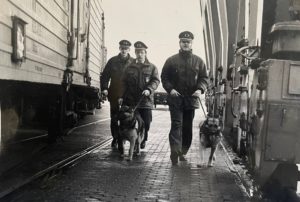
We had the opportunity to speak with K9andSports ambassador Horst-Dieter Träger (Dieter). Dieter is a service dog trainer at customs and responsible for purchase and training for the state of Bremen. Since 1982 he has his own SV Kennel von der Wannaer Höhen. He is a successful handler as well as an SV judge.
Patricia: You once told me that you are not a political person. Now you are a K9andSports ambassador. How come?
Dieter: Dieter: It will be beneficial for all sides if we become more transparent for the public. When I say we, I refer to K9 and the dogsport world, because there is misunderstanding with respect to both. There is no need to hide what we are doing. After all, the work of K9 programs benefits society, while K9 programs rely on dogsport.
The K9 community relies on private working dog breeders and handlers: they are the source to quality dogs.
At the same time, we are seeing that both the sport and breeding approval tests are being soft washed: often with the argument of animal welfare – in my opinion this is based on a lack of understanding. Weaking the selection process, carries the risk that we lose the quality of our dogs. And we absolutely depend on the quality of our dogs.
Patricia: Why do you – or K9 program administrators – depend on dogsport handlers and private breeders for dogs?
Dieter: Because we cannot breed the amount of dogs we actually need. Just recently, I spoke to responsible people with the Bundeswehr, the German Military, who entertain their own breeding program. However, that breeding program is limited to two, maybe three litters per year. Generally speaking, not all dogs from a litter will be suitable for service. If you add up these dogs, the number is not nearly sufficient to meet the actual need.
Public authorities/K9 programs do not have the headcount nor financial background to cover their own need of dogs. The majority of K9 dogs come from private breeders. What does this mean? It’s the private breeders who select dogs and lines when it comes to breeding. We have to work with what we get. And as anyone else, we are subject to rising prices while we are limited in budget. This really sums up, why I hope for K9andSports to make a difference when it comes to breeding and breeding selection. I hope that private breeders will cooperate more with K9 program administrators and that we can maintain or even better the quality of dogs.
Patricia: What kind of dogs are you looking for, broadly speaking? Are all of your K9 dogs trained for protection purposes aside from their speciality?
Dieter: In the past, there was a certain trend away from protection dogs. Some departments only purchased and trained detection dogs in order to avoid the cost associated with dual training.
However, we`ve seen an increase in violant acts against officials and keeping our officials safe is becoming harder. Often, we address people who rely on us not making use of our weapons while disrespecting our orders. This generally will not happen with a trained protection dog at your side.
Patricia: What difference exactly does a dog make?
Dieter: A huge difference. A dog is not predictable for your opponent and in most cases people don’t want to take the risk.
Having said that, we have a hard time purchasing dogs that are made for the job. Personally, I work at Bremerhaven. Imagine a harbour with a lot of noise. Our dogs have to climb a 30 meter gangway prior to getting on a boat. They deal with high temperatures and a lot of noise. Not many dogs work with high motivation and focus in an environment like Bremerhaven. Only a select number of dogs will.
Patricia: How do you test dogs prior to purchasing them?
Dieter: I watched the breed selection test (ZTP) of your dog by the German Malinois Club (DMC) and noticed quite a few of similarities. Just like you, we will watch the handler playing with the dog. We will also evaluate how the dog plays with an unknown person and if the dog is willing to fight for his prey.
We like to see how the dog reacts to “dead” prey; prey that is not moving. It’s generally pretty easy for dogs to show activity for a moving toy. Most dogs will run like a mad hatter after a flying ball. But what if there is no movement? I’ll throw the toy, let the dog watch. But rather than letting the dog go right away, we will turn the dog in circles. Quite a few dogs will not even search for the toy, others will lack intensity or give up their search quickly.
Patricia: What about environmental stability?
Dieter: I always test a dog’s behavior in an unfamiliar surrounding: narrow hallways, slippery floors, etc. However, it can be difficult to know if a dog shows good drive behavior or is high in nervous activity, something we don’t look for. Both look similar.
This is also why we have a four to five week trial period when buying a dog. We’ve had cases in which a dog froze upon an automatic glass door or on slippery floor. These dogs are often trainable to a certain point. However, in my experience, they will never perform 100% compared to a dog who doesn’t have environmental issues.
It takes a lot of time to generalize a behavior. And we don't have the time.
Florian: Exactly, for us that is also a very critical point in the breeding test: does a dog show activity out of temperament or because of weak nerves? We are not looking for dogs who show activity out of excessive nervous activity. The dog we are looking for is intrinsically motivated. Can you tell when watching a sport trial?
Dieter: As a judge, I naturally watch a lot of dogs in trial situations. There is a lot to be seen about the nature of dogs. But it’s not exhaustive.
At SV trials or competitions, I try to see the participants and their dogs outside of the field. For example at a ceremony. There you find out which dogs don’t calm down appropriately or come out of the trailer already stressed and panting. It is important to me that a working dog knows when and how to rest. Everything else is a limitation.
Patricia: So sport, trials are not sufficient for a breed selection in your view?
Dieter: Trials give us a good picture over a long time. However, we also need additional approvals or breeding suitability tests. A complete picture only emerges when we examine the dogs within their routines (trials) AND outside of the program.
One personal example: I once had a bitch that passed a great IGP1; she really convinced me. Four weeks later, I showed her at a show. A regular shot affected her to an extent that it shouldn’t. This might seem strange at first since she experiences gun shots in Obedience trials. I realized that she is different while in her program, her routines that helped her in stabilizing. This made me realize that characteristics can be covered if the dogs knows and anticipates what’s going on. That’s why we test the dogs in trials with known routines AND unknown environments in breeding selection tests.
Florian: How important is it for you that a dog is not affected by the noise of a gun shot?
Dieter: It’s important in a broader sense. In real life, our dogs cannot be affected by the sound of a gun shot. Shooting resistance is undoubtedly important in practice. However, this also goes hand in hand with noise (in)sensitivity, which is at least as important. At the port I work at among other things, iron plates often fall to the ground here. The noise it creates far exceeds that of a shot. Our dogs need to remain stable.
Patricia: I recently read that noise sensitivity is increasing in family dogs. Personally, we don’t come across noise sensitivity in the German Malinois Club. But of course, shot guns are part of Obedience and breed selection tests. Are you experiencing more and more noise sensitivity?
Dieter: I never purchase a dog without testing his reaction to a 9mm when he is not expecting it, for example on a walk. I’ve had cases, but I don’t see the problem growing. Our issue is around the dogs’ nerves, including with Working Line German Shepherds Of course, prey drive and appropriate responses to pressure are highly important. But they are nothing if the dog has weak nerves and cannot calm down after an initial excitement. If a dog remains excited after the trigger is removed, it has no place in breeding in my opinion.
Patricia: You mentioned that you watched my dog's ZTP, the "small" breeding license in the DMC. Was there something missing that you would test?
Dieter: I liked some elements but I would add some.
You had to walk through a group of spectators with your dog off-leash. The dog was neutral and at the same time didn't "cling" to you. This gives me a picture but I would want to see more.
Another good part was the play, in particular when your dog had to jump into a parcours of tunnels and bottles and show activity to get his toy.
Having said that: in my opinion prey drive may help the dog over difficulties. I would like to see how the dog behaves without prey involved. whether it masters slippery floors or a jump onto an obstacle in a calm state.
Florian: That's a good point. We have already had many discussions with authorities who keep service dogs. We see the benefit of testing the dog in difficult environmental conditions in a calm state.
Patricia: When you purchase a dog, will you put a larger emphasis on nose work testing?
Dieter: Yes, I will have the dog search in different situations. For example, just like you, we will throw a ball. But we will remove the dog for a moment before releasing him to the search. Ideally, the dog will still search intensely. It matters less to us whether the dog finds the ball; but we want to see the dog search for 2-3 minutes.
At our training grounds, we have rooms with obstacles such as large tin-coated heating pipes that they need to jump on. Or we will hide the ball in something that falls over when the dog gets close. Sometimes we see dogs that won’t go near anymore.
If I had to summarize what I would like to see in the breeding selection on top of what youo do: resilience without stimulus and expectations.
Florian: These are very good points that we will add to ZTP: evaluate how a dog deals with a difficult situation without drive or prey involved. Another issue is frustration tolerance and drive resistance. Our exercises are too easy, yours are way more demanding in that regard. It may not look difficult from the outside, but it is for the dog.
Patricia: Now one more question about sport: what are your thoughts on removing the stick hit in IGP protection?
Dieter: It’s a shame. Probably a concession to public opinion. The pressure created through the soft stick is not significant for a dog in protection. Having said that, in my 20 years as a judge I have not yet seen many animals retreat from the helper because of the impact of the stick. This actually happens before.
Florian: True – often times the problem arises for the dog even before the stick hit. But generally, the stick has a “meaning”. What if the dog had never been confronted with the stick before?
Dieter: It may well be that the stick loses its importance.
Patricia: You've been a judge for 20 years. Why are you doing this?
Dieter: I enjoy judging. I've been a breeder for years. Reasonable selection requires reasonable guidance in trials. Even if the selection is not comprehensive, it is an important part of it.
Patricia: What don't you like to see in exams?
Dieter: Passive biting. A full and calm grip alone is not enough for me; I ask for some activity. However, this is not encouraged by all judges, if they primarily complain about an unsteady grip when the dog is actually dominating really nicely. For me it is more important that the dogs are active even if they may miss 2cm in the grip.
Patricia: What makes you happy in a trial?
Dieter: When a dog effectively hinders the helper. Of course, this should come from the heart and not as a side effect because a weak dog is trying to get behind the helper for some more peace.
The most important exercise for me is the back transport. I can get more information on the quality of the dog than in the long part. A back transport contains obedience on the one hand and an explosive and immediate reaction to an attack. It’s a very complex exercise.
In the long attack, the dog has time to think about what he will be doing. The dog may be able to see the prey for 20 meters in advance and I'm not always sure if all dogs are clear about what their goal should be.
Florian: Florian: I agree. We see that a lot with Malinois. The dogs run to the helper like crazy, don’t seem to know why they started running and pass by the helper or don’t bite properly. Speed doesn’t always equal quality.
Dieter: Something else comes to my mind: I watched the video of your last IGP exam, Patricia. And that's when I noted that the time between out and attack was too short and not according to the rules. Once a dog outed, we should let him wait for five seconds until the attack. There’s no room for mistakes otherwise or for evaluating the quality of guarding.
I’m always interested in seeing how other kennel clubs work. Things go wrong in SV as well of course. I strongly support cross-club helper testing and standardizing what happens in trials.
For example the opening: it needs to start with pressure not with a prey stimulus. However, in 90% of the time, the helper will not start with pressure. Standardization brings reliability for the handlers.
Florian: I agree. If the style of helpers is standardized, judges have the opportunity to influence training. If you specify how the helpers have to work, training goals will mirrow it.
Dieter: Yes, and sometimes it has to hurt, otherwise we won't change. Some breeds, including the GSDs, have issues with jumping, for example. From my point of view, this is a question of genetics, since the training is largely the same for all breeds. Here, too, one can exert judicial influence. If we take more points for a dog that touches the hurdle, something will change in breeding with time.
Patricia: IGP is a very time consuming sport. Can you think of ways to make it more accessible?
Dieter: We could replace tracking in A with other nose work. Finding tracking fields is not easy in many areas. If we test other nose work, this would definitely make the sport easier and we would probably even have spectators for A during trials and competitions. Almost no one is watching now.
Thank you for this great interview. Lots more to ask. But we will keep those questions to next time.
Dieter: Thank you to both of you!
Patricia: Our Pleasure!



